
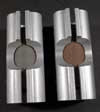

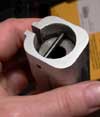
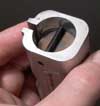

diamond stone
fine stone
The Pro-Filer Skate Sharpener Review
Late 2021 - It appears that Pro-Filers are no longer being made. See footnote 8.
The Pro-Filer is a hand sharpening kit for ice skating blades. Because I once had a "professional" sharpening ruin a pair of blades, I've since been suspicious of sharpening services offered through a rink. I sought a way to do it myself, and I read about the Pro-Filer hand sharpener on the old rec.sport.skating.ice.recreational newsgroup on the Internet.
I've been using this system to sharpen my figure skates since 2002 with good results. I initially purchased a 3/8" radius of hollow to start with. That proved to be too extreme for my skill level back in 2002 and I couldn't do hockey stops. I later purchased the 1/2" radius Pro-Filer kit and found it suitable, but as my skills progressed over the years, I returned to a 3/8" sharpening. The only other radius option from Pro-Filer is an aggressive 5/16" radius that is said to be suitable for thinner dance blades. The slot opening for the blade in my two sharpeners is fixed for freestyle blade thickness, so I don't know how these work with thinner dance blades. It may take extra layers of tape on the side of the blade to shim them to fit.
Each kit comes with two cylindrical grind stones captured in extruded aluminum guides. One stone is advertised to be a diamond abrasive for the rough cut, and the other stone is a finishing stone to remove the minor grooving left by the first one.
The kit also contains a flat stone for removing burrs from the side of the blade, packaged together with cutting fluid (older kits contained a thin cutting oil), a wiping cloth and masking tape to protect the side of the blade. I've found that ordinary Scotch Magic Tape works better than the masking tape. It has a smoother surface and the sharpener glides easier over the Scotch tape.
It takes about an 1/2 hour to one hour for me to do a pair of skates. I sharpen about once or twice each month when I'm skating regularly. If I sharpened more frequently, it would probably take a little less time to do.
Here are some pictures of the 1/2" radius kit sold around 2004. Click on a thumbnail to see a larger version.
 |
 |
 |
| Kit contents (slightly used) | Rough and fine stones | End view of stones |
 |
 |
 |
| End
view of diamond stone |
End
view of fine stone |
Diamond abrasive surface |
A coarse diamond abrasive is adhered to a thick-wall steel tube seen in the end view of the diamond stone. The fine stone is a solid cylinder of an abrasive substance. It must be used with a lubricant such as the supplied honing fluid.
Usage
I tape the sides of the skate blades about 1/8" down from the skating edge to
protect the blade's finish from the sharpener. I use Scotch tape instead of the masking
tape supplied in the kit because it lets the sharpener glide easier.
 <--Click
thumbnails to enlarge the pictures
<--Click
thumbnails to enlarge the pictures
Next I slide the flat stone along the flat side of the blade to remove burrs caused by nicks. Then I put a drop of the supplied honing fluid on the round diamond stone sharpener, and slide it with moderate force along the blade for about a dozen times. I rotate the stone in the holder (to distribute wear), add a drop of fluid, and make another dozen passes over the blade. Repeat until the edge feels sharp again. When it gets too messy, use a paper towel to clean the blade.
On average, I use the diamond stone for about 5-10 minutes, then clean the blade with a paper towel, and switch to the fine stone for another 5-10 minutes. You will get messy fingers. The cutting fluid carries away the removed material, and it gets very black. Don't wear your finest clothes. Note: Since the cutting fluid mixed with metal shavings is abrasive, prickly, and tedious to clean afterwards, I now wear a latex glove on my sharpening hand.
A scan of the
original instructions
for the Pro-Filer can be found here.
Summary
If you're patient, this system might be a reasonable substitute for professional
sharpening - especially if you have no choice. If you are mechanically challenged, this
might not be the system for you. Seek a professional skate sharpener in whom you have
trust. However, the Pro-Filer works fine for me.
Note also that they are designed to work with flat-sided blades. I don't know how they would manage to work with blades that have a "parabolic" profile, or other unusual treatment. I doubt that it's practical to use with them.
Here's a link to the web site of the company (Edge Specialties, Inc.). They sell directly to the consumer.
Maintenance of the fine stone over time
Cutting action of the fine stone can be maintained by dressing its surface
every couple of years. It is common to dress grinding wheels on shop grinders
with diamond abrasive tools. I use the same diamond tool to restore the
Pro-Filer's fine stone efficacy. I created a page showing my method
here.
The coarse diamond sharpening stone in the Pro-Filer kit doesn't collect swarf like the fine stone, so just removing it and washing with a brush in detergent and water is sufficient.
A modification for easier cleaning of the
stones
Cleaning the stones is done with them removed. It takes a bit of work to drive
out the slotted spring pins, so I replaced them with easily removable screws.
Page is here.
Footnote 1: Metal Removal Rate
I was curious about how much material is removed by the Pro-Filer during a
sharpening, so I performed an experiment to measure the rate of metal removal. I hadn't
sharpened my skates for several months (from August through mid-October of 2003
while skating about 10 hours per week) so the edges were very dull to the touch.
These blades were ideal for an experiment to measure the rate of metal removal.
I taped the edges of the skate for sharpening, and made a mark so that I knew where to take measurements during sharpening.
I began sharpening with the 1/2" ROH diamond stone, taking measurements periodically over a two-hour period with a Starrett 1-inch micrometer. I measured the blade section to the edges and to the inside of the hollow. I used a steel ball bearing (0.173 dia.) to reach into the hollow and merely subtracted 0.173 from the total reading to find the distance to the hollow.
When I was finished with the fine stone (determined by a good sharp feel to the edge of the blade), the blade had 0.003 inch removed from the overall section to the edges, and 0.004 removed from the hollow. It makes sense that the hollow needs more metal removed because the edges wear down more compared to the hollow. Calculations show that the worn blade's ROH had effectively become a shallow 1" radius before sharpening.
The starting blade section was 0.797 inch, and after sharpening it was 0.794 inch. It would take quite a few sharpening sessions like this one to remove significant material from the blade to change its rocker geometry or to wear it out.
Footnote 2: Maintains the Original Rocker Shape
I still have the same Coronation Ace ice skating blades after 4-1/2 years. A friend bought a new pair of Coronation Ace blades over the summer of 2006. I was curious how my skate blades, after 4-1/2 years, had maintained their rocker using the Pro-Filer hand sharpening. We traced our blades onto a sheet of paper to compare their shape. Using Photoshop, I brought the two tracings together for comparison and the results are shown below.
Click on the small pictures below to view a larger version...
The other person's skate blades had been machine sharpened about 3 times since new. The tracings are very close and within about one pencil line of each other. On my blades, I had done dozens of hand sharpening using the Pro-Filer plus two machine sharpenings (once when new, and another time when I sent the boots for rebuilding). There isn't much difference between my old blades, and the the new blades. In fact, when a difference is detectable, the other person's blades are starting to show signs of having a flattened rocker from just three machine sharpenings.
(Added 10/2006)
Footnote 3: Updated Kit Contents
A new kit!
I purchased another 3/8" Pro-Filer to replace my well-worn old set. Having been used regularly over the past 9 years, the coarse diamond stone had lost its ability to remove metal efficiently, and sharpening sessions were taking too much time.
Having a fresh coarse diamond stone was a considerable improvement. Sharpening times to raise a slight burr on the edge were shortened by a factor of 3. It was well worth it. The new set, while costing more than what I paid 9 years ago, now includes a zippered carrying case.
Note that replacement stone inserts are sold separately, but it isn't that much additional money to just replace the whole kit.
Here are some photos of the new carrying case and of the 3/8" ROH sharpeners. The 3/8" kit is anodized with a distinctive color.
 |
 |
| New carrying case (click to enlarge) | Inside the case |
 |
 |
| Diamond (coarse) stone | Fine stone |
(Added 4/2011)
Footnote 4: New 7/16" ROH is said to be available (but see note below)
The Pro-Filer is advertised to be available in a new 7/16" radius of hollow (ROH).
Halfway between 1/2" and 3/8" ROH, this is a very common sharpening radius among figure skaters.
NOTE: When I ordered the 7/16" kit, I got a call from Brad Anderson telling me that it's essentially the same as the 3/8" kit. He said that there's only a tiny 0.001" difference between the hollow made by the 3/8" and the 7/16" on most skate blades. I didn't check his math, but decided that I'd just make do with what I had. I really didn't need another 3/8" kit.
(Added 5/2014, note added 12/2014)
Footnote 5: I created a spreadsheet for calculating different depth of hollows produced by various radius of hollow grinds.
The values are good for most figure skating blades that are around 0.155" thick. The following is a screen capture showing most common (and some uncommon) ROH grinds.
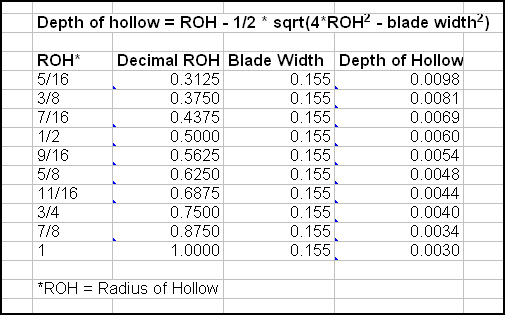
Footnote 6: Getting even edges on blades.
I have evidence that the Pro-Filer can produce uneven edges on a blade, i.e., one edge is higher than the other. It occurs because the user unconsciously applies a small tilt of the Pro-Filer during sharpening. A larger gap between the Pro-Filer guide slot and blade will increase chances that it will happen.
The remedy is to swap the blade orientation a few times during sharpening. For example, start sharpening with the toe pick in front, then after a few passes, turn the skate around to put it in the rear. Swap ends a few times during a session. Any unintended tilt applied by the user will then be spread out over both edges, reducing unevenness.
While these photos show skates that were sharpened by powered skate grinders, they demonstrate how a small piece of wood pressed against the blade can be used to estimate edge levelness.
[click pictures to enlarge]
 |
 |
| Uneven
edges from a bad pro-shop sharpening. You'd notice this. |
After re-sharpening on a Wissota sharpener to restore level edges. |
I keep a small rectangle of 1/8" thick hardboard about 4" or 5" long in my bag. I use it to test the skates of friends at the rink if they suspect trouble. Even a popsicle stick will do.
Footnote 7: A shop-built skate holder for sharpening with a Pro-Filer
Holding skates while undertaking an extended sharpening session with a Pro-Filer can get fatiguing. Also, I wanted an easy way to be able to reverse a skate's orientation and not require more fiddling to hold onto the skate when sharpening (see Footnote 6).
I undertook a small woodshop project to make a skate holder to work with the Pro-Filer. It clamps securely onto the blade to hold the skate. I can quickly turn the jig to sharpen from the other direction to produce even edges. Also it has a removable cover, magnetically attached, for the space to store the Pro-Filer materials after sharpening.
This project is discussed in a thread on Skatingforums, and it shows some construction steps along the way - http://skatingforums.com/index.php?topic=8371.0 I believe that there is a drawing with dimensions in the thread.
Here are a few photos of the unit. Click to enlarge any picture.
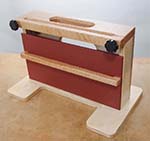 |
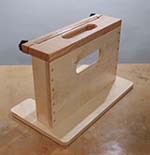 |
 |
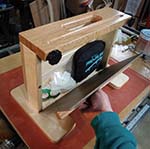 |
Footnote 8: Pro-Filer not currently being manufactured
11/2021 - I read this on a skating forum about the status of Pro-Filer products..
OK. Here's the word from Jan Anderson at Edge
Specialties [Brad and Jan Anderson run Edge Specialties].
* They are retiring.
* They have sold the "pro-filer.com" domain to Wissota.
* They have sold the boot punch, HDI gauge, and rocker bar product lines to
Wissota. These are the products featured on the Edge Specialties page of the
Wissota website (where you land when you enter "pro-filer.com" in a browser).
* Edge Specialties still has some Pro-Filers in inventory for sale. If you are
interested, please contact:
Jan Anderson
Edge Specialties, Inc.
phone 320-808-1536
e-mail
pro-filer@charter.net
Bill Schneider
updated
November 29, 2021